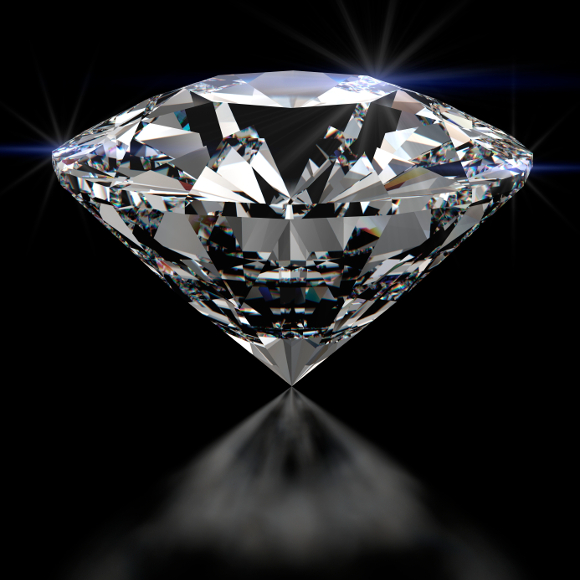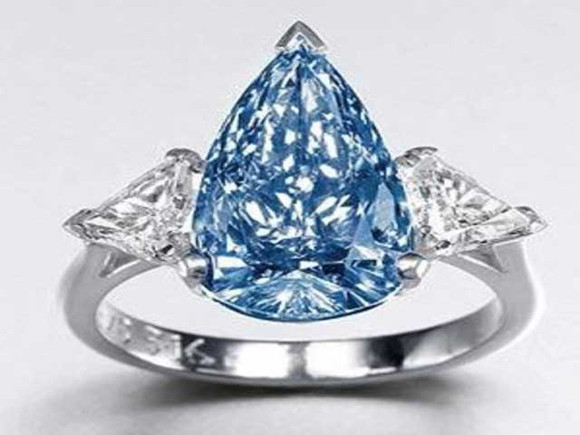Wedding rings come in all sorts of exciting guises. One of the most popular trends right now is for gorgeous diamond wedding rings, especially sparkly and beautiful. They make the whole wedding band thing even more precious and special.
We thought it’d be interesting to look at a bunch of amazing and inspirational diamond facts, taking a peep into the secret life of one of the most desirable natural substances in the universe.

Large Diamond – from diamonds2cash.co.uk
If you’re about to buy a stunning Orla James gem-studded wedding ring or diamond eternity ring, this should whet your appetite!
Brilliant facts about diamonds and their starring role in engagement & wedding rings
- Diamonds are not the hardest natural substance on earth… or not any more. As reported by New Scientist magazine in 2009, the not-so-romantically named wurtzite boron nitride is 18% harder and the mineral lonsdaleite is 58% harder.
- If you heat a diamond to more than 763C it will vanish like magic, leaving absolutely nothing behind, not even dust. At those temperatures the diamond simple expires in a tiny puff of carbon dioxide.
- They might be hard… but they’re also brittle. If you’re ever tempted to hit your diamond ring with a hammer for some strange reason, don’t. The gem will shatter.
- Diamonds take about a billion years to develop and are formed deep in the earth’s crust, at least 90 miles down.
- Synthetic diamonds are much younger. Scientist can grow synthetic stones averaging 2.5 carats in just four days. They contain exact same chemical make-up, but are man-made.
- Moissanite is a simulated diamond so good even experts find it difficult to tell it apart from the real thing.
- Not sure if your diamond is real? Genuine diamonds tend to fluoresce under UV light, glowing in the dark for just a few seconds. Some say it provides a reasonably reliable way to spot fakes.
- Diamonds are brought to the earth’s surface by volcanic activity. Most are found in rock called Kimberlite, which is where the famous Kimberley diamond mine gets its name.
- Why ‘third finger, left hand’? It’s because ancient people thought the finger contained a special vein, the Vena Amoris, which led straight to the heart. Sadly they were wrong, but it’s a lovely story.
- What does ‘diamond’ mean? It comes from the Greek word ‘adamant’, which means invincible.
- Ask any good online wedding ring retailer and they’ll tell you it’s a real challenge to photograph diamonds. They never look quite as deliciously sparkly as they do in real life. When you buy a diamond wedding ring from us, the real deal will be even more spectacular than the photos.
- In Germany, Russia and India people wear their wedding ring on the right hand.
- While yellow gold, white gold and platinum are still very popular, palladium is probably the most fashionable metal for engagement and wedding rings these days, a rare and precious metal with a slightly lower price tag and a luxurious contemporary look.
- Diamonds are 58 times harder than corundum, which is what rubies and sapphires are made from.
- Until the 1400s there was no way to cut diamonds. That’s why at the time diamond rings contained subtle, fiery cabochon stones rather than diamonds cut into sparkly facets.
- Do you have a spare £1.83 million? If so you can afford the planet’s most costly engagement ring, a masterpiece by DeBeers containing an absolutely stunning, perfect, enormous 9 carat gem set in chunky platinum. Wow.
- Luckily for your bank balance, the average stone in a modern engagement ring weighs a lot less at 0.37 carats.
- The world’s biggest ever diamond was the Cullinan, discovered in South Africa in 1905 and weighing just under 3107 carats before it was cut.
- The Cullinan was cut into two famously massive gemstones, the 530 carat Great Star of Africa and the 317.4 carat Lesser Star of Africa. The leftovers went to make another 104 near-flawless stones, which are now part of the Crown Jewels.
- The world’s biggest polished diamond emerged from South Africa in 1986 and weighed 545 carats. Known as ‘Unnamed Brown’, it was cut down from a whopping 700 carat rough diamond. It took an entire team of cutters three years to create the giant gem.
- The Centenary diamond also took three long years to cut, weighing in at just under 274 carats and the world’s biggest ever completely flawless diamond.
- If you thought they were big, you’re in for a surprise. The biggest diamond in the universe is much bigger. Lucy, whose name was inspired by the Beatles tune ‘Lucy in the sky with diamonds’, is a crystallised white dwarf star entirely made of diamond, an amazing 10 billion trillion trillion carats of the stuff.
- ‘Synthetic’ and ‘simulated’ diamonds are different. Simulated diamonds are made from different material, and it isn’t mined, it’s made. But synthetic stones have the same chemical composition as natural diamonds. So, zirconia and moissanite are simulated diamonds, not synthetic.
- December wins hands down for the most popular month to get engaged.
- People have loved diamonds for millennia. The gems were first used in India, around 800BC.
- In 1477 Archduke Maximillian of Austria gave Mary of Burgundy a diamond ring. It’s thought to be the first ever diamond engagement ring.
- Diamonds first appeared in wedding bands and engagement rings in the 1500s.
- The famous Kimberly Process means less than 1% of all diamonds mined are ‘conflict diamonds’.
- Impurities turn diamonds into the most marvellous colours, some of which are even rarer than perfect white diamonds so very desirable. They come in shades of red, orange, yellow, green, blue, grey and even black, which is becoming more popular for engagement rings.
- The most desirable and rare coloured diamonds are the bright, vivid green, pink and blue versions, but even they are nowhere near as rare and desirable as a pure, perfect ruby.
- Only 20% of mined diamonds are good enough to be gem quality. The rest are industrial diamonds, although some are used in cheap jewellery.
- A diamond carat is different from a gold carat. The carat measurement denotes gold’s purity, whereas a diamond carat is about weight.
- One carat of diamond weighs 200 milligrams.
- Unless it’s something incredibly special, a diamond has very little resale or investment value. It’s a love thing, not a money thing.
- Most people choose a round brilliant cut stone, a cut that shows the gem’s legendary qualities off really well, with oodles of lovely bling.
- Diamond certificates don’t guarantee quality unless the stone is laser-marked. It’s better to just buy from a retailer you can trust.
- Buying diamond rings online comes with serious savings of as much as 25% compared to the high street, simply because the costs of running a real-life shop are higher than maintaining a website.
- If you buy a diamond ring abroad, bear in mind it’ll probably get picked up on the way into the country and you’ll be charged import tax.
- How much can you spend on a diamond wedding ring, engagement ring or eternity ring? How long is a piece of string? But as a general rule, most people tend to spend two months’ wages, which averages out at roughly £1800.
- The price of a diamond ring depends on the metal, the size of the stone, its cut and colour, shape, purity and clarity.

Big Diamond Wedding Ring – from fashionjewelleryUSA.blogspot.com
Need help or advice choosing the perfect diamond wedding ring?
Need help? No problem. We love great jewellery, so call us on the local rate number 01903 331 707 to chat with a member of our expert team.
